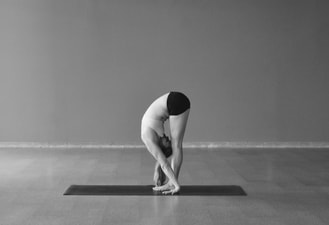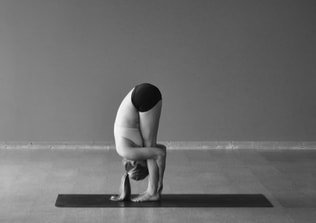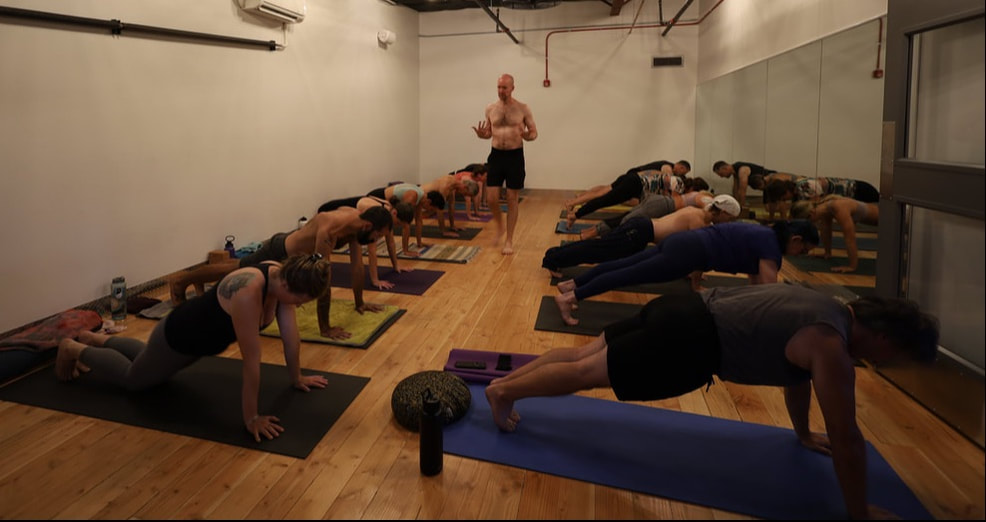|
Over the years, we have started to teach two different versions of Hands to Feet pose. We call these postures Hands to Feet A & B. There are several reasons for this, some of which are historical and others anatomical.
We will focus on the anatomical reasons in this blog, because we've previously written about the historical context. You can find that here. So, what is the difference between the two postures? Hands to Feet A is a forward bend of the spine. It uses the muscle of spinal flexion (rectus abdominis) to round the spine forward and bring the head toward the knees or thighs. If you have ever tried this posture, you probably noticed the intense engagement in the abdomen. However, Hands to Feet B is a hamstrings stretch. In this posture, the pelvis tilts forward. Not only does this require hip flexor engagement, but it also engages the back of the spine. All of this is in services of the hamstrings lengthening. Then, by using arm strength, the upper body is pulled closer to the legs. This is not a forward bend of the spine. It does not use the muscles that bend the spine forward. What does this mean in practice? Either posture is worth practicing. It depends on what we are trying to accomplish. However, it's worth incorporating Hands to Feet A into the Half Moon sequence if we are trying to bend the spine in all directions. Otherwise, if we practice Hands to Feet B only, we bend the spine sideways and backward, but never forward.
1 Comment
Years ago, we were finalists for a job with Yoga Journal. We were excited at the potential of the opportunity. It would take us to many different places and immerse us in many different yoga communities.
But just as we started imagining what the job would be like, we were told we were no longer being considered. It was over. We were disappointed. But then we realized that this was our chance to ask ourselves important questions: What was the yoga world missing? What could we try to build that would fill in these gaps? It was at that moment that we decided to start Practice Week. We wanted to create a space that was purely for practice and study. We had noticed that so often, the next step in a yoga practitioner's path is teacher training. But what about personal practice? Even if we choose to teach, we are all students of yoga first and foremost. We had no idea if anyone would show up when we scheduled the immersion. We figured that if no one attended, we would practice by ourselves for a week. But to our amazement, people did. Practice Week became a space where those new or experienced could gather, solely for the purpose of personal development on the path of yoga. We have hosted Practice Week for years now. Each week is different because each one is influenced by the particular group that attends. Some individuals come back year after year, but each year their practice and their particular interests are different: this is progress. Practice Week is a time to explore these changes and recommit to progress in whatever way it may look next. Sometimes we reflect on what would have happened if we got the job. We're glad we didn't. Instead... we practice! |
AUTHORSScott & Ida are Yoga Acharyas (Masters of Yoga). They are scholars as well as practitioners of yogic postures, breath control and meditation. They are the head teachers of Ghosh Yoga.
POPULAR- The 113 Postures of Ghosh Yoga
- Make the Hamstrings Strong, Not Long - Understanding Chair Posture - Lock the Knee History - It Doesn't Matter If Your Head Is On Your Knee - Bow Pose (Dhanurasana) - 5 Reasons To Backbend - Origins of Standing Bow - The Traditional Yoga In Bikram's Class - What About the Women?! - Through Bishnu's Eyes - Why Teaching Is Not a Personal Practice Categories
All
Archives
May 2024
|









 RSS Feed
RSS Feed